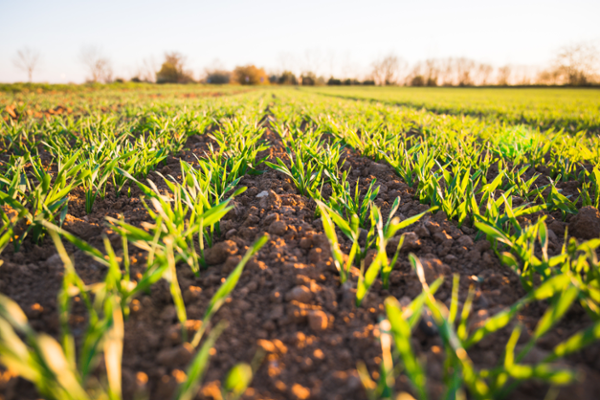
Staying Apart Through Clustering: Review of the research and innovation landscape on food
In 2017, the federal government announced its commitment to develop a national food policy for Canada that will emphasize “community bonding”. The assertion is that “food connects us. It brings us together”. Significant policy efforts and investments in food innovation were launched more than three years ago. How have things changed since then?
By Peter W.B. Phillips, Distinguished Professor, JSGS; Researcher, Centre for the Study of Science and Innovation Policy; Crystal Chan, JSGS Master of Public Policy studentPublic trust in agriculture
The Canadian agri-food R&D landscape
In Canada, the agriculture portfolio is managed by the Department of Agriculture and Agri-Food, also known as the Agriculture and Agri-Food Canada (AAFC). With 21 research centres across the country, the AAFC Research Branch is the largest single performer of agricultural research and development (R&D) in terms of size. AAFC’s expenditures within the Science, Innovation, Adoption and Sustainability category was close to $540 million by 2016.4 Then the Barton Report in 2017 made “agriculture” a cool and trendy word within the national government agenda. Within three years, the government has injected sizeable funding in agriculture and agri-food R&D activities through special programming. Besides numerous AgriScience Clusters and Projects5 and ongoing activities within the research centres that are being maintained by the AAFC under CAP, two additional large-scale research programs are running under the short-lived Canada First Research Excellence Fund (CFREF)—Designing Crops for Global Food Security (also known as Plant Phenotyping and Imaging Research Centre, or P2IRC) led by the University of Saskatchewan (2016) and Food from Thought led by the University of Guelph (2017). The Innovation Superclusters Initiative triggered the creation of Protein Industries Canada (curiously, the only Supercluster in the Prairie Provinces) in 2018. Last year the Innovation, Science and Economic Development Canada (ISED) made investments to two large-scale R&D networks through the new Strategic Innovation Fund—the Canadian Agri-Food Automation and Intelligence Network (CAAIN) and the Canadian Food Innovators Network (CFIN).6 The latter is led by the Canadian Food Innovators who also had its Food and Beverage Processing Cluster renewed under the AgriScience Cluster program in the same year.
On paper, these R&D networks are all national in scope. Upon closer examination, it is apparent that P2IRC, Food from Thought, and to some extent CAAIN, resemble a regional innovation system with a few external linkages. Despite being one of the “Superclusters” in the country, the Protein Industries Canada operates more like an early-stage technology investor and incubator than a R&D Cluster. CFIN’s participants include most provincial food processor associations and food development centres,7 but its operational plan is not yet available. Nevertheless, there is a theme which runs through all these R&D initiatives—they are designed to promote market growth of the Canadian agricultural products through technological advancement (Table 1). A few activities are designed to demonstrate/improve the nutritional value of a food product, with the expectation that Canada will gain an advantage in the global market as a result. Knowledge dissemination and public engagement are encouraged but not mandatory for these programs.
The Natural Sciences and Engineering Research Council of Canada (NSERC) also provides regular funding support for agriculture, life sciences, and to some extent, human health R&D activities. In the 2018/19 fiscal year, NSERC funded more than $43 million on agriculture-related R&D projects and $49 million on life sciences projects. Notably, NSERC also handed out $9 million to projects related to human health. A majority of the awards fall within the $30,000 and $60,000 range and likely serve as salary support for research trainees. NSERC considers project applications regardless of their primary discipline so long as the research activities fall into the “natural sciences and engineering” space. In its 2020 strategic plan, NSERC emphasized adoption of a more “pluralistic, inclusive perspective of science… which embraces all the terms found under the commonly-used acronym, STEM—science, technology, engineering and mathematics”.8 Such a position certainly aligns with the current government’s priority (equity, diversity, and inclusion) and appeals to the public psyche, but might not be very useful to the prospective funding applicants.
Table 1: National R&D Initiatives on Agriculture and Agri-Food Funded by the Federal Government
| Name | Lead Institution | Location(s) | Administering Government Agency | Government Funding | Goals |
| AgriScience Clusters and projects | Varies | Varies | AAFC - AgriScience Cluster Program | Up to $338 million (2018 – 2023) |
Support leading edge discovery and applied science, and innovation driven by industry research priorities |
| Food and Beverage Processing Cluster | Canadian Food Innovators | MB | AAFC - AgriScience Cluster Program | $4.6 million (2018 – 2023) |
Strengthen Canada’s value-added food industry |
| Designing Crops for Global Food Security (also Plant Phenotyping and Imaging Research Centre) | University of Saskatchewan | Primarily SK, with some links to BC, AB, ON, and PQ | CFREF (under the Tri-agency Institutional Programs Secretariat) | $37.2 million | Drive transformative innovation in plant breeding to bolster Canada’s agricultural leadership and improve global food security |
| Food from Thought | University of Guelph | Primarily ON, with some links to PQ and BC | CFREF | $76.6 million | Increase the sustainability and productivity of global food production |
| Protein Industries Canada (PIC) | PIC | Offices in AB, SK, and MB | ISED - Supercluster | Up to $153 million | Make Canada a leading source for plant proteins and, ultimately, feed the world |
| Canadian Agri-Food Automation and Intelligence Network | Alberta Innovates and Vineland Research & Innovation | Primarily AB and ON | ISED - Strategic Innovation Fund | Up to $49.5 million | Accelerate the automation and digitization of Canada’s agricultural sector |
| Canadian Food Innovators Network | Canadian Food Innovators | MB | ISED - Strategic Innovation Fund | Up to $30 million | Accelerate product development, innovation, and technology adoption in Canada’s food and beverage processing sector |
Source: Authors analysis of agri-food research, 2020
For researchers who are working within the food and nutrition space, the Canadian Institutes of Health Research (CIHR) might seem to be the most logical venue to seek research funding. The Institute of Nutrition, Metabolism, and Diabetes (INMD) is one of the 13 institutes within the CIHR system that supports research to “enhance health in relation to diet, digestion, excretion, and metabolism; and to address causes, prevention, screening, diagnosis, treatment, support systems, and palliation for a wide range of conditions and problems associated with hormone, digestive system, kidney, and liver function”.9 Upon closer examination, it will become apparent that INMD places a strong preference on research on chronic diseases such as diabetes (remember insulin is a proud Canadian achievement). In addition to operating grants INMD awarded more than $9 million in funding under the Programmatic Grants in Food and Health in 2013, but gave out just less than $7.5 million (under the “nutrition, food and health” and “planning and dissemination” envelopes) by 2019. In CIHR’s 2014/15 – 2018/19 Strategic Plan, food and nutrition research was embedded within the “healthy environments, food security and safety” research area under the “health promotion and prevention” strategic priority. CIHR has long been criticized for its funding approach and notoriously low success rate (12 – 14%). Currently CIHR is reviewing its funding strategy and will release its 2020 – 2030 Strategic Plan by June 2020. Just in time for its 20th anniversary, but 14 months after the end of its previous plan. It is expected that food and nutrition will continue to remain as an afterthought in CIHR’s future research agenda.
Actions are always louder than words. Despite the progressive appearance, the current R&D programming on the Canadian agri-food, health and nutrition field remains rooted in several outdated beliefs. We continue to be obsessed with productivity growth and are in firm belief that new technologies are the only way to achieve it. When it comes to food and nutrition research, we continue to tackle it from a disease intervention approach (i.e. how do we deal with problems that are associated with obesity?) rather than a prevention approach (i.e. how do we maintain a healthy weight? Is there a better indicator of health other than weight?). We continue to treat farming, food production, diet, nutrition, and health as distinct entities when it comes to research and innovation. Special R&D initiatives are “special” because they are mostly driven by political motivations. Impromptu innovation “policies” attract patchy ideas, or worse yet, ideas that have already failed us in the past. The lack of interdepartmental coordination and collaboration at the government level simply gets further extended to the program level and eventually to the award recipient level. The resulting R&D projects and clusters operate in silos as each of them has its master to serve. With increasing accountability and reporting requirements, there are even less incentives for the awardees to “think outside the box”. More importantly, the larger these R&D programs are, the slower they are to produce results. Loss of project time due to delay in project approval has been noted by AAFC in one of their AgriScience Cluster program evaluation reports.10 Two years after the announcement, ISED has only released $29.9 million out of the $950 million initial budget to the five superclusters.11 It is uncertain whether a delay in project implementation will merely lead to a delay in reaping anticipated benefits, or an outright lost opportunity.
Meanwhile, a majority of the Canadian taxpayers—source of these major investments—remain mostly isolated from these innovation programs. As a case in point is the global beef industry, which has been under attack in the past years due to its perceived harm to both human and environmental health. The confusion around red meat consumption is mounting, and science offers very little reassurance.12 The A&W fast food chain added to the controversy by stating most Canadian beef cannot meet its “added-hormone-free” standards. The popularity of a “plant-based” diet is booming while more health practitioners are encouraging people to reduce red meat consumption. Earlier this year, Our World in Data team published a landmark study confirming beef produces the highest greenhouse gas emission.13 The Canadian beef industry has been a long-time supporter of environmental stewardship research and is able to provide counterevidence highlighting the role of livestock grazing in supporting biodiversity and environmental sustainability. However, these research findings are often dismissed by the general public as the science was deemed to be corrupted by corporate agendas. How do we resolve Canadians’ confusion and skepticism towards our home-grown beef? How do we support the Canadian beef industry as it faces one of the most challenging threats in history? There is not a single solution, but it is obvious that “boosting productivity by technological enhancements” alone—as promised by these flagship R&D programs and networks—will not contribute much.
A change in approach
Food affects social, economic, moral, and environmental concerns in a complex way, so we need to adopt a systems approach when we seek to gain a better understanding of the challenges and opportunities of the current food system, and of the potential impacts of proposed changes and interventions. Research and innovation are key tools to help us advance, but stakeholders within the R&D sector must move away from the “industry-driven” narrative and the linear “technology-productivity-market growth” formula.
The problems of a supply-focused, “produce more with less” model are well-known and will only be amplified if we do not change our approach. A 2019 study conducted by the Value Chain Management International revealed that 58% of Canadian food production is wasted, and this avoidable food waste contributed to more than 22 million tonnes of climate-changing carbon dioxide emissions.14 Increasing agricultural production and productivity, as recommended by many food security strategies, will only generate more food to waste and yet not able to resolve hunger—let alone other types of food insecurity issues. Food waste has long been treated by the R&D sector as an “externality” (or simply, “not my problem”), but can we not “significantly boost food production” simply by making “avoidable food waste” accessible and usable?
Developing a robust food policy requires a collaborative environment in which stakeholders across the food system can connect and communicate. A comprehensive, multi-faceted knowledge base is instrumental because it will give participants a shared communication lexicon. To create such vocabulary, the R&D sector must embrace the notion of “working within a food system”—not agriculture, or nutrition, or environment, but just “food”. Stakeholders within the food system should also actively pursue new partnerships with non-traditional allies to investigate social, cultural, and moral aspects of the system. The government could send out a signal by launching a joint AAFC-CIHR programming on food system innovations.
Addressing public issues must be the top priority of publicly funded R&D endeavors. This is particularly so when it comes to something that is vital to a nation’s health and wellbeing—food. To this end, we need to bring in more diverse narratives and drivers to help redefine priorities and goals within the research design and allocation space. Public engagement needs to be more than just “knowledge transfer” from R&D performers to the general public. It should also be a meaningful conversation with society in which ideas and knowledge are exchanged. We must also constantly remind ourselves that innovation is the process of introducing new ideas, devices, or methods, and technology is just one of the components. The best opportunities for innovation to occur is at the interface between disciplines. Small yet highly adaptive funding programs could support community-driven innovations that are creative, inter-disciplinary, and impactful.
The agriculture and food landscape has changed dramatically in the past decade, both in terms of technological advances and public expectations. We might now be in an era where we are developing technologies too quickly, while ignoring the implications of these technologies when they meet with society. Research and innovation must therefore contribute to the building of public trust, or we are only putting further distance between agriculture and society. It is time for policymakers to move away from large-scale technocentric cluster funding models and adopt an inter-disciplinary, collaborative approach in food research and innovations that advance the health of both individuals and society.
ISSN 2369-0224 (Print) ISSN 2369-0232 (Online)
References
1 Toban Dyck on Macleans, “What Canadians don’t understand about farming – and what they need to”. April 13, 2018. https://www.macleans.ca/opinion/what-canadians-dont-understand-about-farming-and-what-they-need-to/
2 The Canadian Centre for Food Integrity. 2020. “Food Integrity 2019 Public Trust survey”
3 Agriculture and Agri-Food Canada. “Investing in innovative approach to strengthen public trust in Canada’s agricultural sector”. 2018. https://www.canada.ca/en/agriculture-agri-food/news/2018/11/investing-in-innovative-approach-to-strengthen-public-trust-in-canadas-agricultural-sector.html
4 Agriculture and Agri-Food Canada Consolidated Financial Statements (unaudited) for the year ended March 31, 2017. http://www.agr.gc.ca/eng/about-our-department/planning-and-reporting/departmental-financial-statements/agriculture-and-agri-food-canada-consolidated-financial-statements-unaudited-for-the-year-ended-march-31-2017/?id=1505423450920
5 The full list of funded AgriScience Clusters and Projects is readily available on the public domain at the time of writing
6 “Canadian Food Innovators Network Receives $30 million from federal government”. July 22, 2019. https://betakit.com/canadian-food-innovators-network-receives-30-million-from-federal-government/
7 Information from Innovation, Science and Economic Development Canada – Strategic Innovation Fund. 2019. https://www.ic.gc.ca/eic/site/125.nsf/eng/00031.html
8 Natural Science and Engineering Research Council of Canada. 2020. “NSERC 2020 – A Strategic Plan”. https://www.nserc-crsng.gc.ca/nserc-crsng/nserc2020-crsng2020/index_eng.asp
9 Canadian Institutes of Health Research. About Institute of Nutrition, Metabolism and Diabetes. 2011. https://cihr-irsc.gc.ca/e/13522.html
10 Government of Canada. 2014. “Agriculture and Agri-Food Canada, Office of Audit and Evaluation: Evaluation of Agriculture and Agri-Food Canada Innovation and Adaptation Programs”.
11 Jolson Lim for Ipolitics. 2020. “Fraction of funding for federal superclusters plan spent to date”. https://ipolitics.ca/2020/02/14/fraction-of-funding-for-federal-superclusters-plan-spent-to-date/
12 Leslie Young for Global News. 2019. “Red meat good, red meat bad: Why nutrition research can be so hard to follow”. https://globalnews.ca/news/5981469/red-meat-study-nutrition-research/
13 Hannah Ritchie. 2020. “You want to reduce the carbon footprint of your food? Focus on what you eat, not whether your food is local”. https://ourworldindata.org/food-choice-vs-eating-local
14 Rob Weber for the Global News. 2019. “More than half of food produced in Canada is wasted: ‘It would horrify our grandparents’”. https://globalnews.ca/news/4857582/canada-food-waste-study-2019/
Peter W.B. Phillips

Crystal Chan


